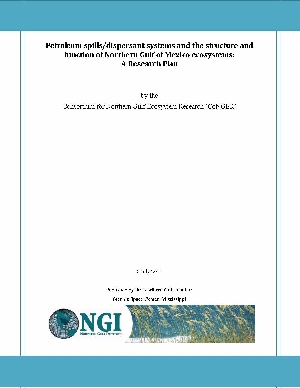Publications at the HPC²
Publication Abstract
Petroleum Spills/Dispersant Systems and the Structure and Function of Northern Gulf of Mexico Ecosystems: A Research Plan
CoNGER, N. G., & McAnally, W. H. (2011). Petroleum Spills/Dispersant Systems and the Structure and Function of Northern Gulf of Mexico Ecosystems: A Research Plan. In Consortium for Northern Gulf Ecosystem Research (Eds.), Stennis Space Center, Mississippi: Northern Gulf Institute. 99.
The Consortium for Northern Gulf Ecosystem Research (CoNGER) begins with the fundamental question: Do petroleum spills/dispersant systems significantly impact the structure and function of Northern Gulf of Mexico (NGoM) ecosystems? CoNGER brings together uniquely qualified researchers from universities, federal agencies, and the private sector in a collaborative effort to answer this question in a transdisciplinary approach. CoNGER proposes four objectives to answer the question and fulfill the GRI mandate: 1) Create fundamental advances in understanding the interactions that occurred and continue to occur between the marine ecosystem and petroleum spills/dispersant systems. 2) Address the fundamental question in a scientifically rigorous fashion. 3) Contribute to a goal of improving environmental health in the face of human activity. 4) Disseminate the research findings to the science and engineering communities and to Gulf of Mexico stakeholders. This proposal addresses the fundamental question and will fulfill the objectives through observations and theory expressed as a conceptual earth ecosystem model (CEEM) integrating complex human, biotic, chemical, and physical interactions of ecosystems as they respond to human and natural system influences, including petroleum spill/dispersant systems. The project is organized as a set of interconnected tasks with each Task having team members from two to seven institutions, each chosen for her/his expertise and ability to function in an interdisciplinary team. The tasks will provide data, analyses, and tools focused on northern Gulf ecosystems and a synthesis to extend those findings Gulf-wide, producing an unprecedented capability of "...improving the environmental robustness of the Gulf ..." as expressed in the RFP. Four coastal sites are selected for detailed analyses, having been the subject of previous and continuing investigations by the Consortium members, so there exist a deep understanding of the sites, an immediate spin-up in data collection, and a historical data record with which new data can be compared. Assessing the impacts of PDS introduced into the Gulf of Mexico on human and environmental health requires quantitative causal relationships to relate the degree and extent of the impact to physical, chemical, and biological processes. Therefore the CEEM will be expressed by a suite of open community models, using and modifying existing models wherever possible, and building a capability to better understand Gulf ecosystems and their health long after this project ends. The models and their results will be made accessible to scientists, resource managers, and the public through unprecedented informatics/data management and Education-Outreach efforts.

